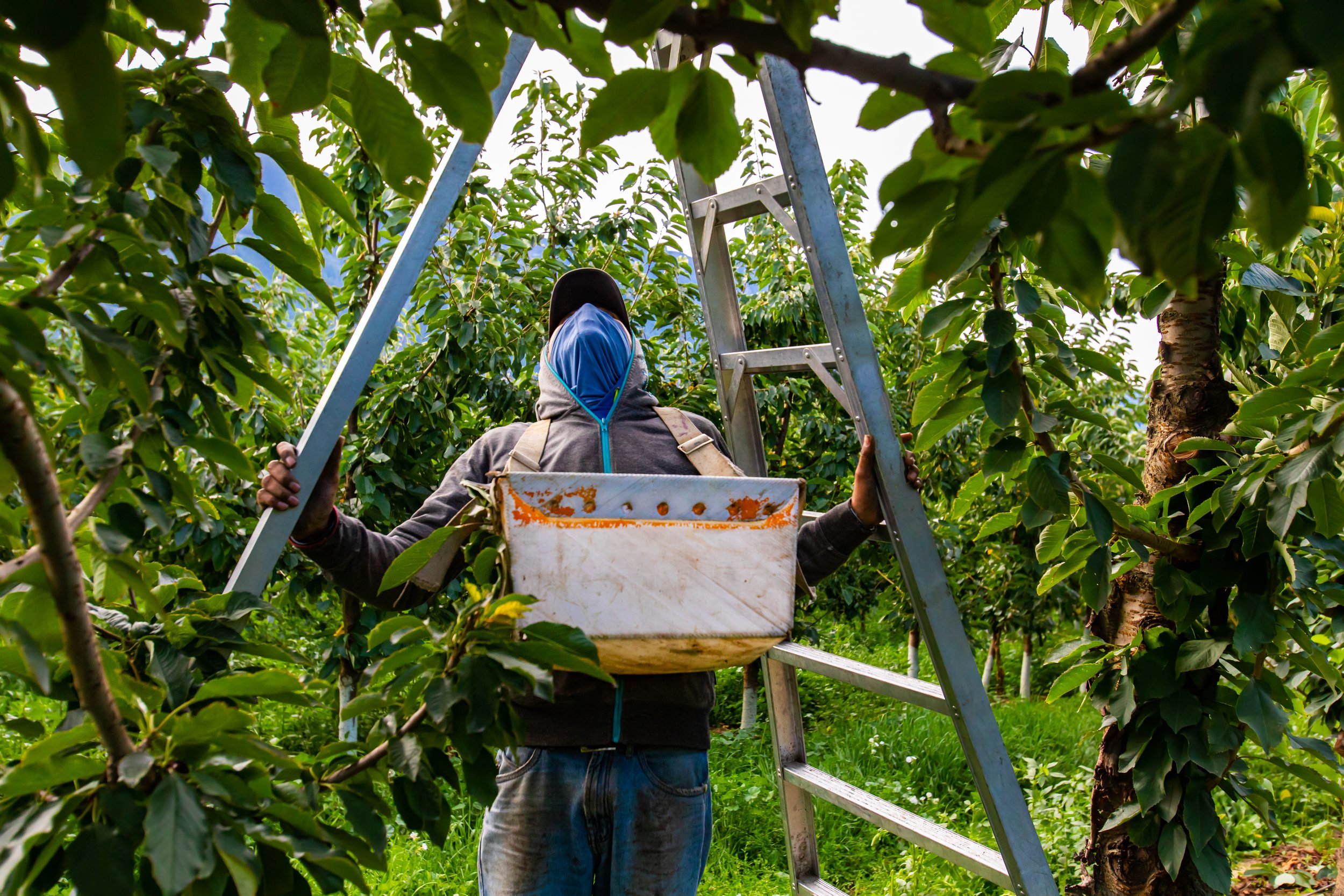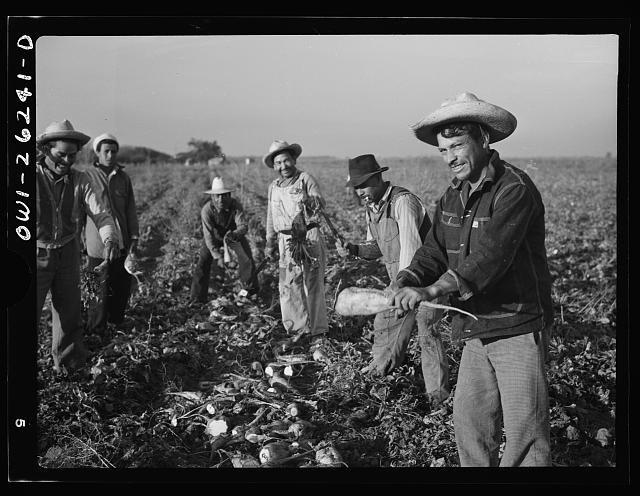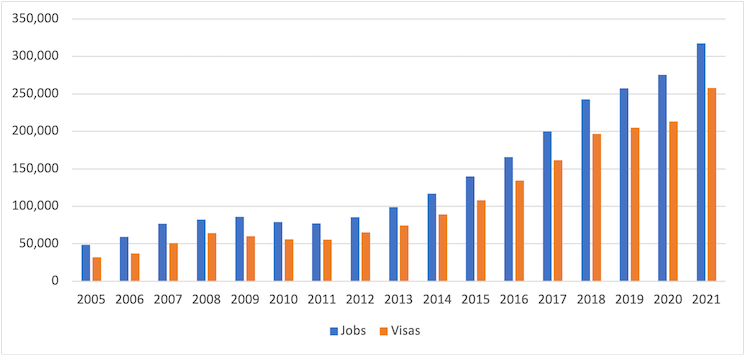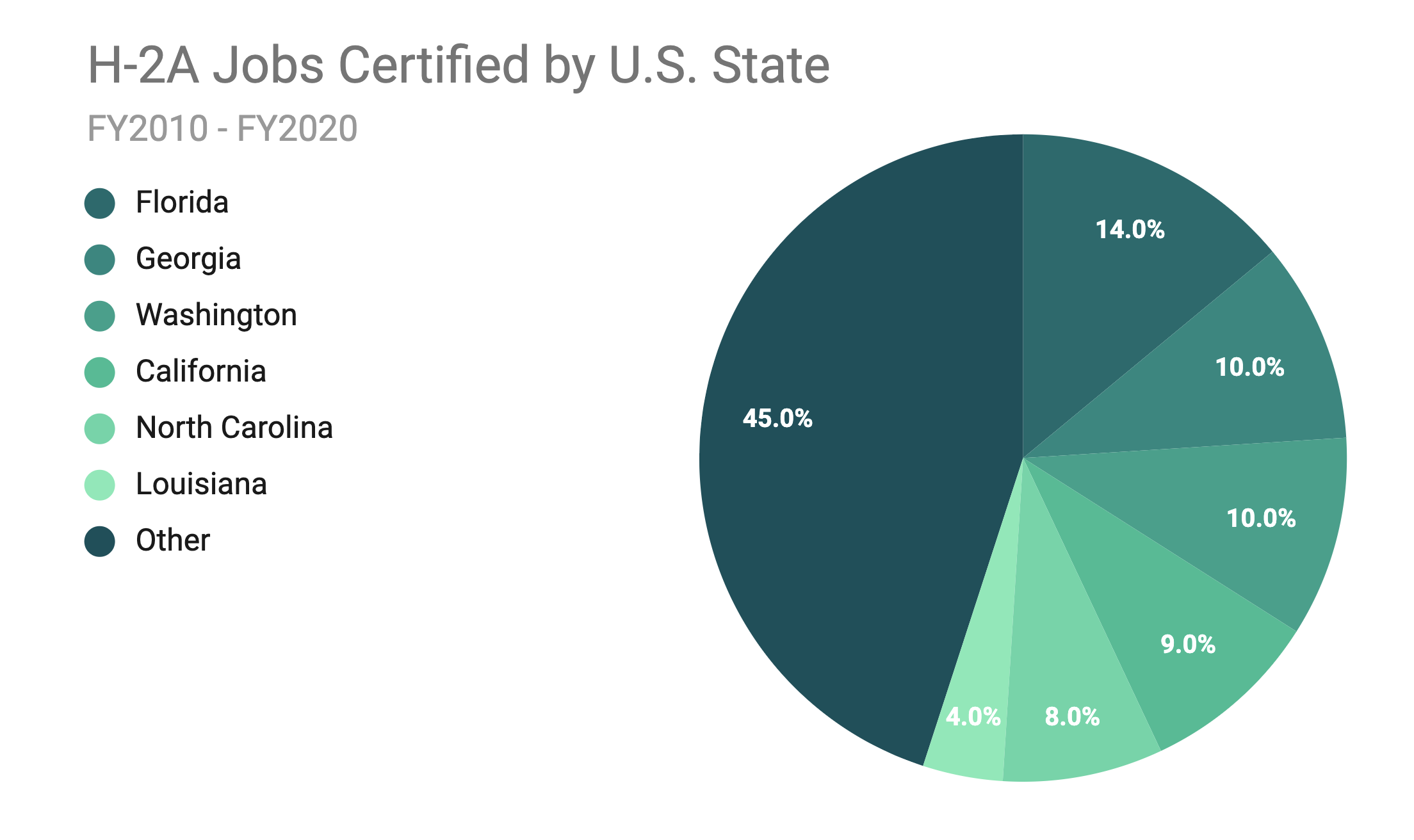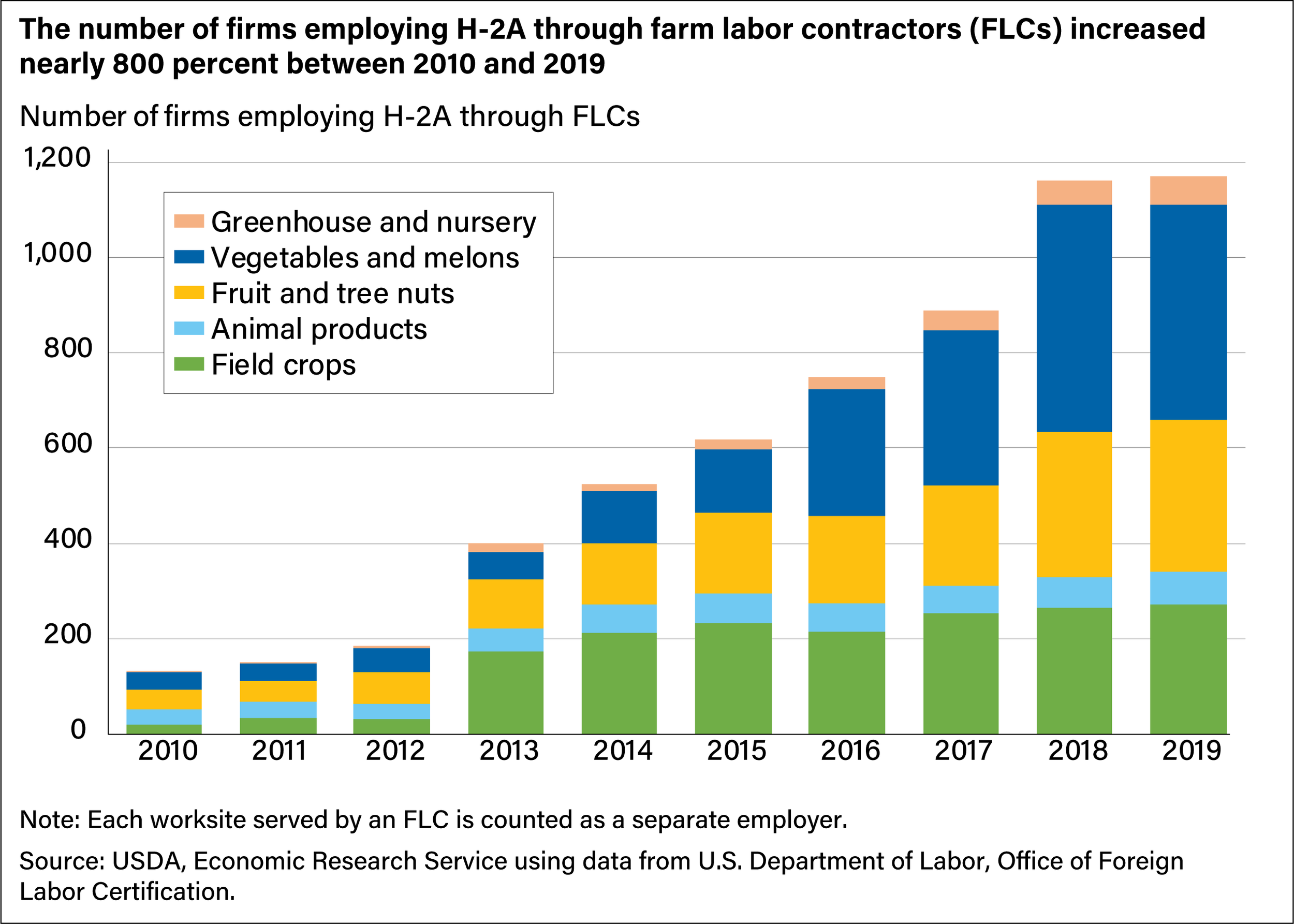Why More Growers are Hiring H-2A Farmworkers
H-2A farmworker picking cherries in Washington
Labor shortages are an obvious problem for the American agriculture industry. Time and time again, we hear there aren’t enough people wanting to do these labor-intensive jobs. Just yesterday, a grower in Washington commented on this topic stating they previously operated on hope:
hope that the workforce would come back
hope that their harvest season started before the farm down the road
hope that their piece rates were enough to attract new farmworkers
But hope isn’t a strategy—so many growers are now turning to the H-2A program.
What is the H-2A program?
Marjory Collins, photographer. Stockton (vicinity), California. Mexican agricultural laborer topping sugar beets.
The H-2A visa is America's most popular temporary worker program. It allows farms to hire temporary or seasonal agricultural laborers if there aren't enough qualified or willing U.S. Americans to fill the post.
Beginning with the Bracero Program in 1942, the United States has a long history of hiring foreign workers, usually from Mexico, for agricultural work. The Immigration Reform and Control Act of 1986 altered the Immigration and Nationality Act to split the pre-existing H-2 visa program into two parts: H-2A for agricultural workers and H-2B for seasonal non-agricultural employees.
The program's primary focus is to provide a legal way to make up for labor shortages.
Where does the H-2A program stand today?
The USDA Economic Research Service says that in the past decade, businesses requesting H-2A workers doubled to over 10,000, while H-2A workers have more than tripled. According to Rural Migration News, the number of certified H-2A jobs tripled between 2013 and 2021 to 317,000.
Specialty crops like vegetables, melons, fruit, and tree nuts represent most of the job growth in the program. H-2A positions in specialty crops have more than quadrupled in the last decade.
To help place these numbers geographically, six states account for 55 percent of H-2A jobs certified in the last decade.
What is behind this growth?
U.S. Department of Agriculture, Economic Research Service recently completed a study that estimates 90 percent of U.S. farm jobs are filled by U.S. domestic workers, but there’s a continued drop in newly arrived immigrants seeking agricultural work, and current domestic farmworkers are finding jobs outside of agriculture or simply aging out. With fewer and fewer local workers applying for agricultural work, the H-2A program is growing as an alternative source of labor.
Considerations of the H-2A Worker Program
Availability
Growers simply cannot find enough local workers to harvest their crops, so the H-2A program’s primary draw is that H-2A workers can provide a more predictable supply of agricultural labor. It is especially challenging for producers of labor-intensive crops that require hand-harvesting, such as fruits and vegetables. It is especially inviting since the program does not currently have a cap on the number of visas issued for H-2A workers.
Cost
A prevailing predicament of the H-2A program is cost. The U.S. Department of Labor outlines that an agricultural employer seeking foreign workers under the H-2A program is required to offer and advertise its recruitment domestically first. Additionally, the wages offered and paid to foreign workers must be equal to or exceed the highest of the following hourly wage rates:
Prevailing wage rate
Federal minimum wage
State minimum wage
Agreed-upon collective bargaining rate
While wages for H-2A workers tend to be based on the AEWR (typically the highest of the above wage rates), employing H-2A workers incurs additional costs such as visa fees, housing, and travel.
Productivity
In a recent conversation hosted by The Western Growers Center for Technology and Innovation, ag experts Matt McGuire, Chief Agricultural Officer at JV Smith Companies, Scott Howington, Owner of Oasis Farming, and Garrett Cardilino, Director of Field Operations at Prime Time International, formed the consensus that the direct costs of hiring an H-2A workforce may be outweighed by its productivity.
“The [H-2A crew] cost per acre is almost identical to domestic because of productivity.”
Matt McGuire shared that when analyzing its crews, “the [H-2A crew] cost per acre is almost identical to domestic because of productivity.” Scott Howington added a similar experience, “harvesting with H-2As is expensive by the hour, but not so much by the box because they are so productive.”
This follows suit to the findings in the same study by the USDA, Economic Research Service, where several FLCs report that H-2A workers pick 15 to 25 percent more boxes or bins of fruits and vegetables per hour than U.S. workers. This is not to say that U.S. domestic workers and H-2As are necessarily unequally productive. For example, H-2As tend to be younger and thus could have a productivity advantage over U.S. domestic workers.
Garrett Cardilino elaborates on why increased productivity is so important: “We have largely converted our seasonal labor needs from local to H2A labor, [...]. There is a perceived increase in cost with H2A labor if an enterprise is only choosing to look at the direct cost comparison. What most decision-makers seem to overlook are the significant negative impacts that absenteeism and inconsistent work quality do to disrupt the cost of opportunity.”
Cardilino continues that, “Not all, but most of the year-round grower-shippers rely on contract sales for our commodities; in simpler terms, we have agreed with buyers to provide a safe and high-quality product to them at an agreed weekly volume and price. Absenteeism and inconsistent deliverables create challenges in our ability to uphold the agreement we’ve signed onto.”
For Cardilino and others, the cost of H-2As is balanced by this increased productivity and reliability. Cardilino concludes, “Factoring in a significantly higher standard of production with almost zero absenteeism allows us to operate in a capacity that, in fact, does guarantee a safe, nutritious, [and] high-quality product [...]. H-2A does that for us and the consumer.”
Flexibility
Another area where the H-2A program can create stress is in its lack of flexibility. Growers must plan harvest many months in advance and decide on the number of H-2As needed based on a guesstimate. Timing of crop maturity and size of yield are variables even tenured farmers can get wrong as it is impossible to predict with 100% accuracy. And yet, H-2A contracts are made in advance with no flexibility if a cold snap wipes out a section of crops or a warmer than usual summer ripens fruit at a more rapid rate. Busses of H-2A workers arrive on pre-negotiated dates, and these rigid parameters can leave growers scrambling.
How does the H-2A Program work?
Here’s a quick overview. Please note: this information is NOT a substitute for reading and adhering to each department's requirements.
Step 1: Obtain a labor certification from the Department of Labor (DOL).
This requires conducting a labor market test with the State Workforce Agency (SWA).
Step 2: Obtain an approved petition from the Department of Homeland Security (DHS) United States Citizenship and Immigration Services (USCIS) for a specific number of workers under the H-2A visa classification.
Step 3: After receiving USCIS petition approval, workers will apply with one of the Department of State (DOS) visa-issuing embassies or consulates abroad for an H-2A visa.
Step 4: After receiving the visa from DOS, workers arrive at a port of entry where DHS’s Customs and Border Protection officers verify eligibility for admission and length of stay.
You may watch an H-2A Program overview webinar from the US Department of Labor for more in-depth information.
What role do Farm Labor Contractors play in the H-2A program?
There are many resources and organizations available to help navigate this process. H-2A Farm Labor Contractors (FLCs), for example, organize all the paperwork and oversee the recruiting process. However, it’s important to note that not all Farm Labor Contractors (FLCs) may be as ethical and caring towards the workforce as one would hope. Recruiters on the Mexican side often ask for bribes from workers who want access to the visa program, and eliminating this kind of corruption is very difficult. While Ganaz does not endorse one particular FLC or association, we have listed trusted organizations at the end of this article and hope that it may help you when finding the workforce you need.
The number of growers employing H-2A workers through a Farm Labor Contractor (FLC) has increased by nearly 800% between 2010 and 2019, according to the USDA Economic Research Service. The table below shows significant growth among growers of vegetables and melons, followed by fruit and tree nuts.
How to onboard and pay H-2As
Many farms decide that the pros far outweigh the cons when taking the leap to sign on to the H-2A program. If you venture into the benefits of an H-2A workforce directly, you’ll need to manage their onboarding paperwork and payroll. That’s where Ganaz comes in.
The Ganaz People Management Platform includes digital HR Onboarding and Payroll Cards, which allows you, as an agricultural employer, to onboard your workforce digitally and issue active paycards on the spot.
You can now issue and activate a payroll card with Ganaz HR Onboarding
The Ganaz HR Onboarding module makes onboarding farmworkers, including H-2A workers, quick and easy. With the Ganaz people management platform, you can say goodbye to tedious, endless procedures like filling out paperwork, data entry, stuffing checks, and printing paystubs while ensuring compliance.
Here is what some of our customers who use an H-2A workforce say:
“It’s a huge time saver, the ability not to have to do anything via paper anymore, just how quick and easy the onboarding process is. What used to take us 20-30 minutes per employee is now just taking a few minutes. We also have the ability to create multiple hiring packets for H2-A, domestic full-time, domestic part-time, and seasonal; and we can pick what group of documents we want for that particular person, and that’s made a world of difference too.”
- Sheila Waulters, AP Manager, Above The Dirt
“The efficiency to have everybody on direct deposit or payroll cards is going to be wonderful. I can’t imagine how anybody else would still keep printing out checks.”
- Olivia Juarez, HR Manager, NWFM
“Ganaz is extremely easy to use for the hiring process, for enrolling into payroll cards, they have made it so user-friendly. And it works really well with integrating into payroll systems so you're not having to sit there for days entering all their W-4 and I-9 information.
The customer service has been great working with Ganaz, if any issues arise, they're the first to jump on it and help us through any problems that we might have.
The communication tool has been really great to use as well regarding like places that we're going to pick or when we think our season's going to start. That sort of communication that in the past was really difficult to have and kind of make it more efficient for the worker and for us.”
- Tiffany Davis, Business Manager, K&K Land and Management
Onboarding and paying your H-2A workforce is only a challenge if you do not have the right partner. Ganaz has the best team and technology to simplify the process.
What is the Future of the H-2A Program?
On March 18, 2021, the House passed the Farm Workforce Modernization Act of 2021; currently, it’s sitting in the Senate.
The Farm Workforce Modernization Act (FWMA) is bipartisan immigration legislation that would provide undocumented farmworkers a path to legal immigration status and citizenship, revise the H-2A program to address employer and worker concerns, and impose employment verification (“E-Verify”) in agriculture. Digging deeper into the fact sheet from the Farmworker Justice Organization, we highlight the proposed modifications as of July 2022.
Migrant and Seasonal Agricultural Worker Protection (AWPA or MSPA)
Heat Stress Protection
Path to immigration status and citizenship for a limited number of H-2A workers
Flexibility in visas - most H-2A jobs would still be seasonal, but H-2A workers would receive 3-year visas.
Preventing Abuse in Foreign Labor Recruitment
Oversight of H-2A Labor Contractors
Revision to the H-2A wages
Application streamlining with a single point-of-access online portal for employers
Introducing year-round H-2A visas for a limited number of employers.
Portable H-2A visa pilot allowing workers to move freely between registered employers.
Industry leaders are currently lobbying on Capital Hill, but they need your voice as well if we hope to get it passed. Call your Senator today.
So… are H-2A Workers for You?
While there is some upfront work to be part of the H-2A program now, if the proposed modifications to the program pass, they will ensure heightened growth. H-2A workers can be a reliable source of labor that complements those you hire locally. With the Ganaz HR Onboarding module, combined with the Ganaz Mastercard Payroll Cards, it’s quick and easy to onboard and pay all your farmworkers, including H-2A workers. To learn more, contact Ganaz today for a discovery call.
This card is issued by Sutton Bank, Member FDIC, pursuant to a license by Mastercard. Mastercard is a registered trademark, and the circles design is a trademark of Mastercard International Incorporated.
Resources to find the right Farm Labor Contractor
While Ganaz doesn’t endorse one particular FLC or association, we have listed trusted organizations that may help and guide you to find the workforce you need.
AgSocio
AgSocio is an agricultural labor and service provider operating in California and Arizona. They help their clients comply and compete in the highly regulated and rapidly evolving agricultural labor market.
They are building a more just, safe, professional, efficient, and competitive agricultural employment system to benefit farmers, farmworkers, and the broader food industry.
California Farm Labor Contractor Association
The California Farm Labor Contractor Association (CFLCA) provides invaluable services and benefits for farm labor contractors, growers, and affiliated organizations who serve the agriculture industry. From mandated licensing education to advocacy and labor management best practices, CFLCA supports you and your unique needs to run a successful and compliant ag operation. Their sole focus is the betterment of the farm labor contracting industry.
CIERTO
CIERTO is a certified farm labor contractor that recruits, trains, and places experienced agricultural workers from Mexico and Guatemala on farms in North America.
Their mission is to create a professional agricultural workforce that comes to your farm free from fear and unreasonable debt, ready to focus on the job at hand – helping you feed the world.
Since 2016, they’ve led the way in demonstrating that transformational recruiting isn’t just the right thing to do… It’s good business.

